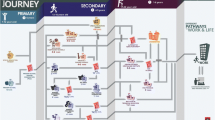Abstract
Mobile devices have become especially enticing to schools because of their portability, flexibility, and intuitive interfaces. A growing number of schools have begun using tablets as a cost-effective strategy in a digital learning environment. Other schools have embraced a bring your own device (BYOD) policy, which addresses pedagogical goals as well as the lack of funds many schools struggle with to support digital learning. BYOD makes digital learning easier by leveraging the devices students already have. The purpose of this study was to explore a digital learning initiative implementation in a large public school district in southwest Florida in order to provide formative feedback to guide its digital learning initiative beyond the initial implementation.


Similar content being viewed by others
References
Abel, N. (2016). What is personalized learning? [Blog post]. Retrieved from https://www.inacol.org/news/what-is-personalized-learning/ Accessed 2 October 2017.
Adams Becker, S., Freeman, A., Giesinger Hall, C., Cummins, M., & Yuhnke, B. (2016). NMC/CoSN horizon report: 2016 K-12 edition. Austin: The New Media Consortium.
Afshari, M., Ghavifekr, S., Siraj, S., & Jing, D. (2013). Students’ attitudes towards computer-assisted language learning. Behavioral Sciences, 103, 852–859.
Bogdan, R. C., & Biklen, S. K. (2003). Qualitative research for education: an introduction to theories and methods (4th ed.). New York: Pearson Education Group.
Bonanno, P. (2011). Developing an Instrument to Assess Teachers’ Readiness for Technology-Enhanced Learning. Paper presented at 14th Annual International Collaboration for Learning: ICL. https://doi.org/10.1109/ICL.2011.6059622.
Creswell, J. (2003). Research design: qualitative, quantitative, and mixed methods approach. Thousand Oaks: Sage Publications.
Creswell, J. W., Hanson, W. E., Clark, P., Vicki, L., & Morales, A. (2007). Qualitative research designs: selection and implementation. The Counseling Psychologist, 35(2), 236–264. https://doi.org/10.1177/0011000006287390.
Ertmer, P. A., Ottenbreit-Leftwich, A. T., Sadik, O., Sendurur, E., & Sendurur, P. (2012). Teacher beliefs and technology integration practices: a critical relationship. Computers and Education, 59(2), 423–435.
Glaser, B. (1978). Theoretical sensitivity: advances in the methodology of grounded theory. Mill Valley: Sociology Press.
Glaser, B. G., & Strauss, A. L. (1967). Discovery of grounded theory. Mill Valley: Sociology Press.
Glesne, C. (2006). Becoming qualitative researchers: an introduction. Boston: Allyn and Bacon.
Guba, E., & Lincoln, Y. (1988). Do inquiry paradigms imply inquiry methodologies? In D. M. Fetterman (Ed.), Qualitative approaches to evaluation in education. New York: Praeger.
Gura, M., & Percy, B. (2005). Recapturing technology for education: keeping tomorrow in today’s classrooms. Lanham: Scarecrow Education.
Honebein, P., Duffy, T. M., & Fishman, B. (1993). Constructivism and the design of learning environments: context and authentic activities for learning. In T. M. Duffy, J. Lowyck, & D. Jonassen (Eds.), Designing environments for constructivist learning. Heidelberg: Springer-Verlag.
Johnson, L., Adams Becker, S., Cummins, M., Estrada, V., Freeman, A., & Ludgate, H. (2013). NMC horizon report: 2013 K-12 edition. Austin: The New Media Consortium.
Johnson, L., Adams Becker, S., Estrada, V., & Freeman, A. (2014). NMC horizon report: 2014 K-12 edition. Austin: The New Media Consortium.
Johnson, L., Adams Becker, S., Estrada, V., & Freeman, A. (2015). NMC horizon report: 2015 K-12 edition. Austin: The New Media Consortium.
Lincoln, Y. S., & Guba, E. G. (1985). Naturalistic inquiry. Beverly Hills: Sage Publications.
Merriam, S. (1998). Qualitative research and case study applications in education. San Francisco: Jossey-Bass.
Merriam, S. (2009). Qualitative research: a guide to design and implementation (2nd ed.). San Francisco: Jossey-Bass.
Miles, M. B., & Huberman, A. M. (1994). Qualitative data analysis: a sourcebook of new methods (2nd ed.). Thousand Oaks: Sage Publications.
Partnership for 21st Century Skills. (2015). P21 framework definitions. Retrieved from http://www.p21.org/storage/documents/docs/P21_Framework_Definitions_New_Logo_2015.pdf Accessed 2 October 2017.
Patton, M. Q. (2002). Qualitative research and evaluation methods. Thousand Oaks: Sage Publications.
Peshkin, A. (1988). In search of subjectivity: one’s own. Educational Researcher, 17(7), 17–21.
Polly, D., & Hannafin, M. J. (2010). Reexamining technology’s role in learner-centered professional development. Educational Technology Research and Development, 58(5), 557–571.
Ruggiero, D., & Mong, C. J. (2015). The teacher technology integration experience: practice and reflection in the classroom. Journal of Information Technology Education Research, 14, 161–178.
Sabzian, F., & Gilakjani, A. P. (2013). Teachers’ attitudes about computer technology training, professional development, integration, experience, anxiety and literacy in English language teaching and learning. International Journal of Applied Science and Technology, 3(1), 67–75.
Shuler, C. (2009). Pockets of potential: using mobile technologies to promote children’s learning. New York: The Joan Ganz Cooney Center at Sesame Workshop.
Singh, T. K. R., & Chan, S. (2014). Teacher readiness on ICT integration in teaching-learning: a Malaysian case study. International Journal of Asian Social Science, 4, 874–885.
Summak, M., Baglibel, M., & Samancioglu, M. (2010). Technology readiness of primary school teachers: a case study in Turkey. Procedia Social and Behavioral Sciences, 2, 2671–2675.
Wolcott, H. (1994). Transforming qualitative data: description, analysis and interpretation. Thousand Oaks: Sage Publications.
Yin, R. K. (1984). Case study research design and methods. Beverly Hills: Sage Publications.
Yin, R. K. (2014). Case study research: design and methods. Los Angeles: Sage.
Author information
Authors and Affiliations
Corresponding author
Ethics declarations
Conflict of Interest
The authors declare that they have no conflict of interest.
Ethical Approval
All procedures performed in studies involving human participants were in accordance with the ethical standards of the institutional and/or national research committee and with the 1964 Helsinki declaration and its later amendments or comparable ethical standards.
Informed Consent
Informed consent was obtained from all individual participants included in the study.
Rights and permissions
About this article
Cite this article
Stork, M.G. Implementing a Digital Learning Initiative: a Case Study in K-12 Classrooms. J Form Des Learn 2, 36–48 (2018). https://doi.org/10.1007/s41686-017-0013-1
Published:
Issue Date:
DOI: https://doi.org/10.1007/s41686-017-0013-1




